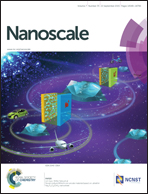The photoirradiation induced p–n junction in naphthylamine-based organic photovoltaic cells†
Abstract
The bulk heterojunction (BHJ) plays an indispensable role in organic photovoltaics, and thus has been investigated extensively in recent years. While a p–n heterojunction is usually fabricated using two different donor and acceptor materials such as poly(3-hexylthiophene-2,5-diyl) (P3HT) and phenyl-C61-butyric acid methyl ester (PCBM), it is really rare that such a BHJ is constructed by a single entity. Here, we presented a photoirradiation-induced p–n heterojunction in naphthylamine-based organic photovoltaic cells, where naphthylamine as a typical p-type semiconductor could be oxidized under photoirradiation and transformed into a new semiconductor with the n-type character. The p–n heterojunction was realized using both the remaining naphthylamine and its oxidative product, giving rise to the performance improvement in organic photovoltaic devices. The experimental results show that the power conversion efficiency (PCE) of the devices could be achieved up to 1.79% and 0.43% in solution and thin film processes, respectively. Importantly, this technology using naphthylamine does not require classic P3HT and PCBM to realize the p–n heterojunction, thereby simplifying the device fabrication process. The present approach opens up a promising route for the development of novel materials applicable to the p–n heterojunction.


 Please wait while we load your content...
Please wait while we load your content...